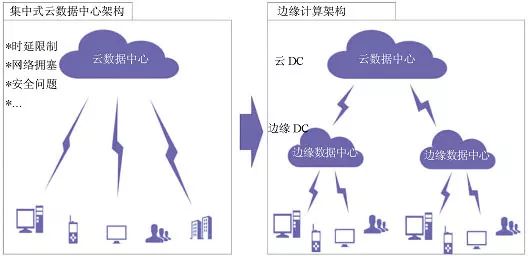Introduction

With the advent of the 5G era, to better support high-density, high-bandwidth, and low-latency business scenarios, the industry proposes to shift from the “core computing” model to the edge computing model, solving network transmission problems nearby. The promotion of the edge computing model urgently requires changes at the infrastructure level—edge data centers have become an effective solution. Currently, edge data centers are in their early stages of development, but the momentum for growth is rapid, with major telecom operators, internet giants, and capable IDC service providers in China beginning to lay out their technologies. The next few years are a critical period for the development of edge data centers, necessitating in-depth research and industrial cooperation from the industry to jointly promote the development of the edge data center industry in China.
1. Introduction
(1) Edge Computing Replacing Core Computing in the 5G Era
In recent years, the rapid development of mobile network communication technology in China, especially the Internet of Things (IoT), has brought new demands for network communication technology, transitioning from the 4G era to the 5G era. The transmission rate of 5G has significantly increased, and network latency has greatly decreased. In the future, 5G will be widely applied in various aspects of life, such as autonomous vehicles, drone flights, VR/AR, mobile healthcare, etc. These business scenarios not only require extremely low and deterministic network latency but also massive, heterogeneous, and diverse data access. Against this background, centralized computing processing models will face insurmountable bottlenecks and pressures, making edge computing models an effective solution. The edge computing model builds a distributed open platform close to the source of data or objects, providing edge intelligent services nearby, meeting the critical needs of industry digitization in agile connectivity, real-time business, data optimization, application intelligence, and security and privacy protection.
(2) New Technical Support Needed at the Infrastructure Level Under Edge Computing—Edge Data Centers
In the development of various emerging information technologies, their ultimate implementation requires support at the infrastructure level to truly realize promotion and application through changes in the data center field. With the promotion of cloud computing technology, the cloudification of data centers has achieved virtualization of computing, storage, and networks, promoting the intensive and high-density development of data centers and greatly improving resource utilization. With the promotion of big data technology, data centers have exponentially increased computing capabilities, further intensifying and high-density development to provide infrastructure support for big data services. As the edge computing model is promoted, what technical requirements will it impose on data centers?
In the edge computing model, to better support high-density, high-bandwidth, and low-latency business scenarios, the only effective way is to build business platforms close to users at the network edge, providing resources such as storage, computing, and networking, and pushing some key business applications down to the access network edge to reduce bandwidth and latency losses caused by network transmission and multi-level forwarding.
This new type of infrastructure built at the network edge differs from centralized cloud data centers and has the following technical characteristics:
● In terms of network transmission: Massive data no longer needs to be uploaded to the cloud for processing, significantly reducing network latency; at the same time, the pressure on core network transmission decreases, avoiding network congestion and greatly increasing network transmission rates.
● In terms of reliability: Edge data centers become the first entry point for data and should have the capacity for real-time analysis and processing of massive business data, as well as high-performance data processing and transmission reliability.
● In terms of deployment characteristics: Edge data centers are deployed very close to the source of information, with localized (city-level and below) deployment characteristics, widely distributed, only meeting local user needs, and having characteristics such as small scale, large numbers, and decentralized deployment.
The industry refers to this new type of infrastructure deployed at the network edge as edge data centers, which are located between the user end and centralized cloud data centers, providing a miniaturized, distributed, and user-friendly data center environment. Therefore, the network support layer changes from the original two layers (centralized cloud data center: user end) to three layers (centralized cloud data center: edge data center: user end), as shown in Figure 1.

Figure 1 Comparison of Centralized Cloud Data Center Architecture and Edge Data Center Architecture
2. Main Technical Application Scenarios
Edge data centers are born to support the development of lower-latency 5G new services. Due to the extremely high terminal density supported by 5G, the data volume it brings will also be astonishing. By using edge data centers to migrate IT resources from cloud data centers closer to the user side, data processing will be more efficient. At the same time, edge data centers can effectively promote the implementation of emerging technologies such as 5G, artificial intelligence, and the Internet of Things, accelerating the promotion of these emerging technologies in various traditional fields and facilitating the emergence of new business forms. For example, in the transportation field, the integration of 5G and IoT technology promotes the scaling of intelligent driving car businesses; in the healthcare field, the integration of 5G and AR/VR technology promotes the scaling of remote healthcare (including remote surgeries, remote monitoring, etc.).
(1) 5G Mobile Communication Technology
The construction of edge data centers helps support the development of lower-latency 5G new services. By migrating IT resources from the central office to the base station side, it can be made closer to users, effectively reducing latency. The integration of edge data centers with 5G communication, IoT, artificial intelligence, and other emerging technologies accelerates their path to scale, leading to the emergence of new business forms such as smart transportation (like autonomous vehicles), smart finance (like unattended financial outlets), smart education (like future classrooms), and smart security (like safe cities).
Telecom operators will leverage NFV and MEC technologies to cloudify CDN network elements and sink them down to edge nodes close to end users, deploying them in next-generation central offices to ensure resource elasticity and maximize utilization, effectively alleviating network pressure and providing users with a better experience.
(2) Internet of Vehicles
Edge data centers can greatly support the Internet of Vehicles by “sinking” the vehicle network cloud to edge data centers, such as communication base stations, small base stations, and aggregation points, providing core capabilities of network, computing, storage, and applications for the vehicle networking platform, solving latency, bandwidth, and computing performance issues. By running mobile edge computing applications, various vehicle networking functions can be provided nearby, enabling safe avoidance, speed guidance, path optimization, regional traffic flow analysis, etc., ultimately serving the realization of autonomous driving.
(3) CDN
The inherent edge node property of CDN gives it a first-mover advantage in the edge computing market; CDN itself is the prototype of edge computing. Future CDNs will require a large number of edge devices, whether transitioning from CDN to edge computing or incorporating edge computing concepts into the existing CDN system, utilizing edge computing to enhance the competitiveness of CDN is a great choice. The edge computing model can assist CDNs to be smarter, more efficient, and more stable. Building edge data centers, leveraging NFV and MEC technologies, cloudifying CDN network elements, and sinking them down to edge nodes close to end users can ensure resource elasticity and maximize utilization, effectively alleviating network pressure and providing users with a better experience.
(4) AR/VR
Augmented Reality (AR) technology encompasses multimedia, 3D modeling, real-time video display and control, multi-sensor fusion, real-time tracking and registration, and scene integration technologies and methods. Virtual Reality (VR) technology also integrates various technologies, including real-time 3D computer graphics technology, wide-angle (wide-field) stereoscopic display technology, tracking technology for the observer’s head, eyes, and hands, as well as haptic/force feedback, stereo sound, network transmission, and voice input/output technologies. AR/VR experiences are resource-intensive and require fast response times. Existing network infrastructures limit the development of AR/VR; in the future, the technological architecture of edge data centers will enhance the computing capability of AR/VR, significantly reducing network latency and greatly improving user experience.
3. Technology Development Trends
(1) Current Status of Edge Data Center Development in China
Currently, edge data centers are in their early stages of development, but their application prospects are broad, and China’s telecommunications and internet companies are beginning to lay out their technologies. From the ODCC 2018 annual summit, various research institutions, operators, and equipment manufacturers in the industry are paying attention to edge computing and edge data centers. At the summit, the research results released by ODCC in the “White Paper on Application Scenarios of Edge Data Centers” received significant attention from the industry. Telecom operators have begun nationwide large-scale planning and construction of edge data centers; Huawei has built an edge computing development testing platform and is conducting technical research in key areas such as industrial wireless, data integration, SDN, and security; internet giants like Alibaba have started promoting edge computing products for different computing scenarios; and some capable IDC service providers have also begun to co-build edge data centers with telecom operators.
(2) Technology Development Trends of Edge Data Centers
In the future, the data center industry will present a polarized development model of “edge data centers + cloud data centers”. On one hand, driven by cloud computing and new operation technologies, as well as market competition, cloud data center resources are gradually consolidating, showing a trend of large-scale and high-density development; on the other hand, a large number of small and micro edge data centers will emerge to ensure the support of latency-sensitive services on the edge.
Edge data centers will adopt a distributed architecture. Physically dispersed edge data centers will logically form a whole, and they will interconnect through networks with larger bandwidth, requiring a comprehensive scheduling platform to manage and dynamically schedule edge data centers in different geographical locations.
In the coming years, centralized cloud data centers will not disappear. Business data volume and computing volume for centralized storage, data mining, and analysis are enormous, still requiring robust cloud platforms for centralized and efficient processing. Transferring all computing to the edge could lead to distributed and unguaranteed chaos.
User-side capabilities are limited, and to better support business promotion, edge data centers are superior. For example, in the case of autonomous vehicles, if edge data centers are not introduced, but instead, a single vehicle is equipped with sufficient sensing devices, computing power, and large-capacity onboard computing units to handle various environmental data and communicate with other vehicles in real time, it will face significant costs for hardware and safety monitoring, consume more power, and greatly increase the probability of mechanical failure, making it unsuitable for industrial promotion.
Edge data centers are not just small data centers. In the future, edge data centers will be the first entry point for data, and their deployment environment is often open, complex, and harsh, requiring advanced cooling, high safety and reliability solutions, unattended operations, automated maintenance, distributed architectures, and exponentially increased computing capabilities as technical support.
4. Analysis of Existing Problems in China
Although edge data centers are small in scale, they are numerous and have a vast total, physically dispersed, which will have a significant impact on China’s data center industry. Major telecom operators, IDC service providers, equipment manufacturers, etc., are beginning to lay out their technologies, but they face many problems in their technical research and promotion applications.
(1) Difficulty in Adapting to Current Data Center Layout Policies and Municipal Management Methods
Currently, national and local government data center layout policies are all formulated for centralized cloud data centers, advocating reasonable layout and green development of data centers, while edge data centers, with their small scale and large numbers, are difficult to adapt to relevant policies. For example, in Beijing, the government’s published “Prohibited and Restricted Directory for New Industries in Beijing (2015 Edition)” stipulates that the construction and expansion of data centers are prohibited (except for cloud computing data centers with a PUE value below 1.5); in the 2018 version, this was changed to prohibit the construction and expansion of data centers.
Edge data centers will have diverse deployment modes based on business needs. They can rely on traditional machine room environments, 5G base stations, production workshops, rooftops, parks, warehouses, and other spatial environments. Mass deployment of edge data centers in these environments will bring a series of issues related to municipal and environmental management, power supply, network supply, and water supply.
(2) Research Resources Difficult to Align and Form Synergy
Telecom operators, data center service providers, communication companies, and large internet enterprises all have their own advantages and resources in edge data center technology research and promotion. However, currently, based on their respective business characteristics, these enterprises have different understandings of edge data centers, and their research directions vary, making it difficult to achieve resource sharing and complementary advantages.
New information technologies such as 5G, edge data centers, IoT, artificial intelligence, and the Internet of Vehicles can only show their true charm through integrated development. However, research units and groups engaged in these technologies belong to different fields, have varying understandings of edge data centers, and lack a unified communication and exchange platform. Most importantly, the concepts of edge cloud and edge data centers are confused, and some manufacturers overlook the research on infrastructure, blindly pursuing new concepts, resulting in the inability of data center technologies to achieve synchronized development and truly realize technological landing.
(3) Incremental Construction and Existing Stock Transformation Both Face Dilemmas
In terms of incremental construction, business demands are difficult to estimate, and large-scale short-term construction may lead to resource waste. Firstly, it is challenging to accurately estimate future business development, as most business demands, such as IoT’s demand for IT equipment, are still in theoretical calculation or verification stages, combined with the continuous improvement of IT equipment and data center performance, making demand difficult to quantify accurately; secondly, some businesses will gradually sink, and business demands will emerge progressively with technological development. During a certain period, business demands are difficult to estimate accurately.
In terms of existing stock transformation, some machine rooms have low construction levels and are difficult to transform. Telecom operators have a large number of telecom machine rooms, but the conditions of data center machine rooms vary greatly among different levels; for city-level and county-level data centers, the conditions of machine rooms are relatively good. However, for aggregation-level and access-level data centers, although the demand is high, the machine room area is generally small, and the conditions are relatively poor, making transformation difficult.
5. Suggestions for Future Industrial Development
(1) Suggestion for Government to Formulate Practical Edge Data Center Development Policies
The next few years are a critical period for constructing a new generation of information infrastructure, urgently requiring the integration of China’s overall green development goals for the data center industry. While ensuring the continuous implementation of existing policies related to cloud data centers, it is necessary to formulate practical edge data center development policies. Firstly, based on overall development planning, encourage and support the promotion and application of edge data center technologies, providing corresponding support at the policy level to support the construction of 5G network infrastructure and promote the development of new industries such as IoT and artificial intelligence. Secondly, in conjunction with the current state of the data industry, promote research on key technologies to drive the development of edge data centers from a foundational technological perspective.
(2) Suggestion for the Industry to Formulate and Promote Standards Related to Edge Data Centers
There is currently a lack of unified standards for edge data centers. Firstly, the industry lacks a unified definition of edge data centers and is unclear about the boundaries between cloud data centers and edge data centers; secondly, future edge data centers will have different deployment methods, such as existing edge data center types that include telecom operators’ transformed end office machine room data centers, data centers being constructed in large numbers in residential properties, and external cabinets for 5G base stations. It is urgent to classify different deployment methods of edge data centers; thirdly, some edge data center users believe that the level of edge data centers does not need to be very high, such as CDN business users; while some users believe that edge data centers need to be of high level, such as vehicle network business users. Therefore, the formulation of standards for the construction, operation, and grading of edge data centers is currently a pressing issue.
(3) Suggestion for the Industry to Conduct In-Depth Research and Industrial Cooperation
Due to the significant differences in technical architecture between edge data centers and cloud data centers, requiring high safety and reliability solutions, stricter remote operation and access control technologies, and the realization of distributed architectures, it is not suitable to apply the original technical routes related to cloud data centers. Therefore, on one hand, it is recommended that the industry conduct technical research related to edge data centers, including but not limited to energy efficiency indicators, network architecture, operation and maintenance, access control, safety, and reliability; on the other hand, it is suggested that various manufacturers along the data center supply chain, including basic telecom operators, third-party IDC service providers, and IT equipment manufacturers, engage in in-depth cooperation to achieve resource sharing and complementary advantages, jointly promoting the development of China’s edge data center industry.
Author Profile

Zhu Xiaoyun
This article was published in the second issue of 2019 of the “Information Communication Technology and Policy”.
“Information Communication Technology and Policy”

Published by the Ministry of Industry and Information Technology and the China Academy of Information and Communications Technology, the “Telecom Network Technology” (monthly) officially changed its name to “Information Communication Technology and Policy” in March 2018. This publication extends its coverage from the traditional telecommunications field to the information, communication, and ICT fields. It focuses on interpreting industry policies and standards, reporting on major national scientific research project results, and the latest and hottest products and technical solutions in the industry.
Main Columns: Special Topics, Expert Forums, Industry and Policy, Development Strategies, Testing, Products and Technical Solutions.
Submission Email: [email protected]
Reviewed by | Chen Li, Shan Shan
Edited by | Ling Xiao

Recommended Reading


